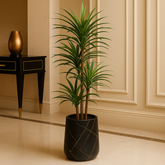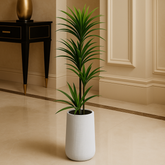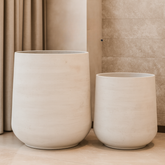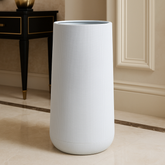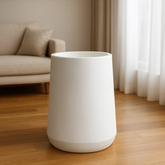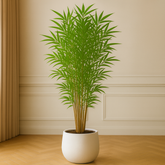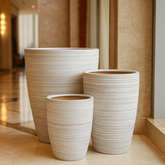الأثاث الخشبي مقابل الأثاث المعدني: اختيار الأنسب لمساحتك
في عالم تأثيث المنازل والمكاتب، تلعب خامة أثاثك دورًا حاسمًا في تحديد جمالية مساحتك ومتانتها ووظيفتها. من بين المواد العديدة المتاحة، يبرز الخشب والمعدن كأكثر الخيارات شيوعًا. لكل منهما مزايا وعيوب خاصة به تلبي مختلف الأذواق والبيئات. تتعمق هذه المقالة في خصائص وإيجابيات وسلبيات الأثاث الخشبي والمعدني لمساعدتك على اتخاذ قرار مدروس بشأن مساحتك.
مقدمة عن مواد الأثاث
لا يقتصر الاختيار بين الأثاث الخشبي والمعدني على الذوق الشخصي فحسب، بل يتعلق أيضًا بمدى توافق كل مادة مع متطلبات المساحة لديك، وأنماط الاستخدام، وقدرات الصيانة. في دولة الإمارات العربية المتحدة، حيث يُعدّ المناخ عاملاً حاسماً في طول عمر الأثاث وجاذبيته، يصبح فهم خصائص هذه المواد أكثر أهمية.
الأثاث الخشبي: أناقة ودفء لا حدود لهما
الخشب مرادف للدفء والخلود والجمال الطبيعي. لطالما كان مادة مفضلة لقرون بفضل تنوعه ومتانته. تكمن جاذبية الخشب الجمالية في عروقه الفريدة وملمسه وتنوعه، مع خيارات متنوعة تتراوح من خشب الورد الهندي والساج إلى خشب البلوط والقيقب.

مزايا الأثاث الخشبي
· المتانة: يمكن للأثاث الخشبي عالي الجودة، مثل تلك المصنوعة من خشب الساج أو البلوط، أن يدوم لعقود من الزمن إذا تم صيانته بشكل صحيح، مما يجعله استثمارًا طويل الأجل.
· التنوع: يمكن نحت الخشب وتشكيله بأشكال مختلفة، من التقليدية إلى الحديثة، لتناسب أي ديكور منزلي.
· الجماليات: تعمل الحبوب الطبيعية ودفء الخشب على تعزيز الجاذبية الجمالية لأي غرفة، مما يوفر بيئة مريحة ومرحبة.
عيوب الأثاث الخشبي
· الصيانة: يتطلب الخشب صيانة منتظمة مثل التلميع والحماية من الرطوبة لمنع الانحناء أو التلف.
· التكلفة: يمكن أن تكون القطع الخشبية عالية الجودة باهظة الثمن بسبب تكلفة المواد الخام والحرفية المستخدمة.
الأثاث المعدني: جاذبية عصرية وبسيطة
من ناحية أخرى، غالبًا ما يرتبط الأثاث المعدني بالتصميم المعاصر والجماليات الصناعية الأنيقة. تُستخدم المعادن، كالفولاذ والألمنيوم والحديد المطاوع، بشكل شائع في صناعة الأثاث نظرًا لمتانتها ومظهرها الأنيق.
مزايا الأثاث المعدني
· القوة: الأثاث المعدني متين للغاية ويمكنه تحمل التآكل والتلف بشكل كبير، مما يجعله مثاليًا للمناطق ذات الاستخدام العالي.
· صيانة منخفضة: المعدن أقل عرضة للتلف بسبب الانسكابات أو الحرارة ويتطلب عمومًا صيانة أقل من الخشب.
· فعّال من حيث التكلفة: عادةً ما يكون الأثاث المعدني أكثر تكلفة ويوفر خيارًا رائعًا لأولئك الذين لديهم ميزانية محدودة.
عيوب الأثاث المعدني
· مرونة التصميم المحدودة: على عكس الخشب، يوفر المعدن خيارات أقل من حيث التصميمات والتشطيبات.
· المظهر البارد: يمكن أن يعطي المعدن في بعض الأحيان شعورًا باردًا أو أقل ترحيبًا بالمكان، على عكس دفء الخشب.
تحليل مقارن: الخشب مقابل المعدن
| وجه | خشب | معدن |
|---|---|---|
| متانة | عالية مع الرعاية المناسبة | عالية جدًا |
| صيانة | يتطلب التلميع المنتظم والتعامل الدقيق | الحد الأدنى من الصيانة |
| يكلف | أعلى عموما | أقل عموما |
| الجاذبية الجمالية | أنماط الحبوب الدافئة والمتنوعة | أنيق وعصري |
اختيار المادة المناسبة لمساحتك
عند الاختيار بين الأثاث الخشبي والمعدني، هناك عدة عوامل يجب مراعاتها:
١. وظيفة الغرفة: ركّز على مكان استخدام الأثاث. قد تستفيد المناطق ذات الحركة الكثيفة، مثل غرف الطعام أو مساحات العمل، من طاولات معدنية متينة، فهي مقاومة للتلف والتآكل مع مرور الوقت. من ناحية أخرى، يمكن لقطعة خشبية أن توفر الدفء والراحة والأناقة اللازمة لغرفة معيشة أو مكتب منزلي.
٢. البيئة: قد يحتاج أثاثك إلى تحمّل عوامل بيئية مُحددة، وذلك حسب مكان سكنك. إذا كنت تعيش في مناخ رطب كالإمارات العربية المتحدة أو المناطق الاستوائية، فاختر موادًا مثل المعدن، وخاصةً الفولاذ المقاوم للصدأ أو الألومنيوم، لأنها تتحمّل الرطوبة دون أن تصدأ أو تُؤثّر على بنيتها. مع ذلك، يُمكن للخشب المُعالَج جيدًا أن يزدهر في هذه البيئات، ويُضفي عليه لمسة جمالية فريدة.
٣. تفضيلات الأسلوب: يُشكّل الأسلوب جزءًا أساسيًا من عملية اتخاذ القرار. يُعدّ الخشب خيارًا مثاليًا للمساحات التي تسعى إلى مظهر ريفي أو تقليدي أو انتقائي. في المقابل، غالبًا ما يُناسب الأثاث المعدني التصاميم البسيطة والحديثة والصناعية، مُضفيًا لمسة جمالية أنيقة وبسيطة.
٤. الميزانية: تتفاوت أسعار الأثاث الخشبي والمعدني بشكل كبير، تبعًا لعوامل مثل الجودة والتصميم والعلامة التجارية. مع ذلك، تذكر أن الاستثمار في أثاث عالي الجودة يوفر التكاليف على المدى الطويل، إذ يدوم لفترة أطول ويحافظ على قيمته بشكل أفضل.
شعبية الأثاث الخشبي والمعدني
وفقًا لتقرير صادر عن شركة Grand View Research، بلغت قيمة سوق الأثاث العالمي 545.6 مليار دولار أمريكي في عام 2020، ومن المتوقع أن ينمو بنسبة 3.4% سنويًا من عام 2021 إلى عام 2028. ومع هذه الصناعة الضخمة:
حافظ الأثاث الخشبي على شعبيته بفضل متانته وتعدد استخداماته وجاذبيته الكلاسيكية. ووفقًا للتقرير نفسه، شكّل الأثاث الخشبي 60% من إجمالي سوق الأثاث في عام 2020.
· وفي الوقت نفسه، يكتسب الأثاث المعدني شعبية متزايدة، وخاصة في المساحات التجارية والخارجية، بسبب مظهره العصري ومتانته وحاجته إلى الصيانة المنخفضة.
دمج الخشب والمعادن في المساحات الحديثة
يُتيح مزيج الأثاث الخشبي والمعدني الجمع بين أفضل ما في العالمين. ويمكن أن يُفضي مزج هذه المواد إلى حلول تصميمية فريدة تجمع بين أناقة الخشب ووظائف المعدن الأنيقة. ويهدف هذا التكامل تحديدًا إلى خلق بيئة متوازنة تتكامل فيها المادتان.
فيما يلي جدول يوضح كيف يمكن للغرف المختلفة الاستفادة من الأثاث الخشبي والمعدني:
| غرفة | أثاث خشبي | أثاث معدني |
|---|---|---|
| غرفة الجلوس | مريحة وأنيقة ويمكن أن توفر شعورًا بالدفء والراحة | مناسب للموضوعات الحديثة ويمكن أن يوفر مظهرًا جماليًا أنيقًا وبسيطًا |
| غرفة الطعام | مظهر كلاسيكي، مناسب أكثر للأنماط التقليدية أو الريفية | متين وسهل التنظيف، مما يجعله مناسبًا للمساحات التي بها انسكابات منتظمة |
| غرفة النوم | يوفر شعورًا بالراحة ويمكن أن يمتزج مع أنماط مختلفة | عصري وعملي، ويمكنه إضافة لمسة صناعية أنيقة |
| في الهواء الطلق | مع العلاج المناسب، يمكن أن يتحمل العوامل الجوية ويضيف لمسة طبيعية | عصري وعملي، ويمكنه إضافة لمسة صناعية أنيقة |
النقاط الرئيسية
يتطلب اختيار أثاث خشبي أو معدني لمساحتك دراسةً متعمقةً لعوامل متعددة، بدءًا من الجمالية والمتانة وصولًا إلى المناخ وسهولة الصيانة. بتقييم هذه الجوانب وفهم تداعيات كل خيار، يمكنك تجهيز مساحتك بقطع لا تُعزز جمالها فحسب، بل تُضفي عليها قيمةً دائمةً أيضًا. سواءً كان سحر الخشب الخالد أو أناقة المعدن، ستجد ما يُناسب كل مساحة وأسلوب واحتياجات.
للحصول على تشكيلة متنوعة من خيارات الأثاث التي تناسب مختلف الأذواق والتفضيلات، استكشفوا تشكيلات أثاث Wooden Twist . وإذا كنتم في دبي وترغبون في خدمة سريعة، ففكروا في خدمة التوصيل السريعة خلال ساعتين .
العناصر الجديدة الساخنة
Wooden Twist Artificial Dracaena Reflexa Plant 220cm Premium Tall Indoor Floor Plant for Home & Office Decor _ Realistic Green Leaves
- AED 799.00
AED 1,499.00- AED 799.00
- (-47%)
- سعر الوحدة
- / per
- AED 799.00
AED 1,499.00- AED 799.00
- (-47%)
- سعر الوحدة
- / per
Wooden Twist Artificial Dracaena Reflexa Plant 190cm Premium Tall Indoor Floor Plant for Home & Office Decor Realistic Green Leaves
- AED 520.00
AED 1,099.00- AED 520.00
- (-53%)
- سعر الوحدة
- / per
- AED 520.00
AED 1,099.00- AED 520.00
- (-53%)
- سعر الوحدة
- / per
Wooden Twist Premium Fiberglass Planter Pot Luxury Indoor Outdoor Plant Pot
- من AED 499.00
AED 999.00- من AED 499.00
- (-50%)
- سعر الوحدة
- / per
- من AED 499.00
AED 999.00- من AED 499.00
- (-50%)
- سعر الوحدة
- / per
Wooden Twist Premium 30x80 cm Tall White Textured Planter Modern Decor Pot
- AED 320.00
AED 559.00- AED 320.00
- (-43%)
- سعر الوحدة
- / per
- AED 320.00
AED 559.00- AED 320.00
- (-43%)
- سعر الوحدة
- / per
Wooden Twist White Textured Planter Pot 30X64 cm Modern Light Weight Indoor & Outdoor Flower Pot for Home & Office Décor
- AED 299.00
AED 599.00- AED 299.00
- (-50%)
- سعر الوحدة
- / per
- AED 299.00
AED 599.00- AED 299.00
- (-50%)
- سعر الوحدة
- / per
Wooden Twist White Textured Planter Pot 28x28cm Modern Light Weight Indoor & Outdoor Flower Pot for Home & Office Décor
- AED 199.00
AED 249.00- AED 199.00
- (-20%)
- سعر الوحدة
- / per
- AED 199.00
AED 249.00- AED 199.00
- (-20%)
- سعر الوحدة
- / per
Wooden Twist Luxury 210cm Artificial Bamboo Tree Tall Indoor Decorative Plant for Home & Office
- AED 540.00
AED 1,199.00- AED 540.00
- (-55%)
- سعر الوحدة
- / per
- AED 540.00
AED 1,199.00- AED 540.00
- (-55%)
- سعر الوحدة
- / per
Wooden Twist Modern Textured Ceramic Planter Pot Striped Design for Indoor Home & Office Décor
- من AED 199.00
AED 299.00- من AED 199.00
- (-52%)
- سعر الوحدة
- / per
- من AED 199.00
AED 299.00- من AED 199.00
- (-52%)
- سعر الوحدة
- / per


